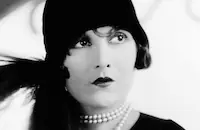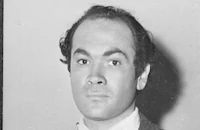Panama Lady

Brief Synopsis
Cast & Crew
Jack Hively
Lucille Ball
Allan Lane
Steffi Duna
Evelyn Brent
Donald Briggs
Film Details
Technical Specs

Synopsis
Lucy, a cabaret girl stranded in Panama, is so desperate for money that she reluctantly agrees to join bar girls Lenore and Pearl in robbing Dennis McTeague, one of their drunken customers. When he awakens, McTeague summons the police, and to save herself from jail, Lucy agrees to accompany him to South America, where he is drilling for oil, and work as his housekeeper. Before departing, Lucy leaves a note for Roy Harmon, her boyfriend, telling him that she has gone with McTeague. When Roy, a smuggler, receives the note, he has just been raided and, assuming that Lucy was the person who tipped off his enemies, goes after her. Meanwhile, in the jungles of South America, Lucy has fallen in love with McTeague, engendering the jealousy of Cheema, his native girl friend. Roy arrives just as McTeague strikes oil and decides to steal the claim papers, but is prevented from doing so by Cheema, who kills him and then frames her rival, Lucy, for the murder. When McTeague returns from his oil camp and learns of Lucy's danger, he forces her to return to the States for her own protection. Later, McTeague, now a rich man, finds Lucy in New York, and the past is forgotton as both realize that their earlier association was the beginning of love.

Director
Jack Hively
Cast

Lucille Ball
Allan Lane

Steffi Duna

Evelyn Brent
Donald Briggs
Bernadene Hayes

Abner Biberman
William Pawley
Earle Hodgins
Crew
Albert D'agostino
Garrett Fort
J. Roy Hunt
Michael Kanin
Lee Marcus
Hugh Mcdowell Jr.
Van Nest Polglase
Cliff Reid
J. Dewey Starkey
Edward Stevenson
Vernon L. Walker
Theron Warth
Roy Webb

Videos
Movie Clip


Film Details
Technical Specs

Articles
Panama Lady
By the time Ball made Panama Lady, she was beginning to wonder if she were ever going to get anywhere at RKO, the studio that had signed her in 1935. After a few unbilled roles, she had begun to demonstrate real comic potential, particularly with a supporting role in Stage Door (1937). But despite growing popularity as a radio comedienne and the star of the screwball comedies The Affairs of Annabel and its sequel, Annabel Takes a Tour (both 1938), she was having a hard time landing quality roles at RKO. The problem was her affair with studio producer Pandro S. Berman, who was married and which made it hard for publicists to use her personal life to generate copy. When their relationship ended, Berman was reluctant to cast Ball in his own productions, and so were the studio's other major producers. The result was a series of quickly made studio potboilers, most with second-string male stars who gave Ball little to work with and whose presence did little to bolster her box office. Yet such was her natural charm on screen that even in lackluster films she attracted attention, earning the title at RKO of "Queen of the Bs."
In 1939, the studio decided to remake Panama Flo, a 1932 tearjerker starring their resident hard-luck dame of the time, Helen Twelvetrees, as an entertainer forced to take a job as housekeeper for an oilman when she's stranded in the tropics. The film had already faded from memory when Clark Gable and Jean Harlow burned up the screen in MGM's much better tropic romance Red Dust (1932) a few months later. Nonetheless, RKO needed low-budget product to meet its contracts with distributors, so remaking an existing script seemed like a good idea. With the story's suggestive situations (Lucy falls for her employer, inciting the wrath of his other live-in servant, a sultry native girl) and melodramatic situations (Lucy's ex-boyfriend, a smuggler, turns up to steal the oil claim, only for the native to shoot him and frame her romantic rival), it seemed an easy way to fill 65 minutes at the bottom half of a double bill.
The toll of making low-budget films back to back was wearing on Ball. Filming on Panama Lady was delayed several times by illnesses. To make matters worse, while shooting one scene, she narrowly avoided being set on fire. While sitting in the studio mock-up of the seaplane transporting her character to and from the oil field, she noticed sparks from the ceiling showering the prop plane's highly flammable wooden wing. She jumped from her seat into the studio pool, all four feet of it, to avoid a disaster in the making.
Yet despite her disappointment with the assignment, she dug into her role, creating the kind of tough fatalism that would become a mainstay of RKO's films noirs in the '40s. And for once, she had a leading man who rose to the occasion with her. Allan Lane had been laboring in minor roles at RKO for a few years and had even co-starred in another of Ball's B movies there, Twelve Crowded Hours (1939). Whether it was the familiarity from having worked together previously or the kinship of two talented actors trapped in what must have felt like B-movie hell, the two struck sparks off each other, creating a powerful image of two losers suddenly finding their lives turned around by love. Lane would finally come into his own when he signed with Republic Pictures, where he would star in serials like The Tiger Woman (1944) and a string of popular Westerns. Like Ball, he would find his greatest fame in television, though not on-screen. Lane would provide the off-screen voice for Mr. Ed for the popular TV series' eight-year run.
Panama Lady received mostly negative reviews, but Ball had a champion in Wanda Hale of the New York Daily News, who called her performance "a minor triumph" and urged RKO to give her better roles. Her entreaties were largely ignored. When Orson Welles arrived at the studio in 1940, one of the first projects he proposed was a vehicle for Ball, only to be told that she was not good enough to carry a picture. It took leaving RKO, followed by a decade of hard work at MGM and other studios, before she finally struck gold as one of television's first major stars. Ironically, with the success of I Love Lucy, Ball ended up owning the RKO lot, where she had made so many B movies in the '30s. In later years, Panama Lady has survived principally for the curiosity of seeing the vivacious, attractive young actress in a dramatic role long before she became the red-headed queen of comedy.
Producer: Cliff Reid
Director: Jack Hively
Screenplay: Michael Kanin
Based on a story by Garrett Fort
Cinematography: J. Roy Hunt
Art Direction: Van Nest Polglase
Score: Roy Webb
Cast: Lucille Ball (Lucy), Allan Lane (McTeague), Steffi Duna (Cheema), Evelyn Brent (Lenore), Donald Briggs (Roy Harmon), Bernadene Hayes (Pearl), Abner Biberman (Elisha).
BW-66m.
by Frank Miller

Panama Lady
Quotes
Trivia
Notes
The working title of this film was The Second Shot. It was a remake of RKO's 1932 film Panama Flo.














